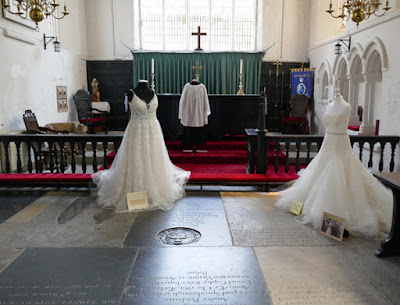Entering the Church of St. Mary the Virgin by the north porch, having previously had a look at the masonry on the exterior and walked around Sprotbrough to photograph its listed buildings for the British Listed Buildings Photo Challenge, I was very surprised to see that the wedding dress here was just one of many others that were part of an exhibition.
Having seen various phases of building on the exterior, I was disappointed to see that all of the walls have been plastered and that the archaeological evidence for these are obscured. With many parts of the church also not being easily accessible due to the dresses, I just took a few quick snaps of the principal elements and spent most of my time looking at the details.
Pevsner describes the arcades and chancel arch as being Perpendicular Gothic in style, with Historic England adding that the piers are octagonal with moulded capitals, but the church guide draws attention to the semi-circular respond and late Norman style capital at the east end of the north arcade, which are considered to be from the original chancel arch and dated to c.1170.
I took a few photographs of the wall memorials to William Wrightson (d.1760), the builder of Cusworth Hall, and of Lionel Copley (d.1766) - both of which are made with white and grey Italian marbles – and the alabaster memorial to Richard Heber Wrightson (d.1891), who subsequently inherited Cusworth Hall.
Moving down to the chancel, the remains of the C13 window and the sedilia have been whitewashed but, carefully making my way around the wedding dresses, I did manage to find a few objects of interest to this Language of Stone Blog.
The sanctuary seat, which was found buried in the rectory garden, has tracery and a caryatid bust of a bearded man that are considered by Pevsner to make it certainly of at least a C14 date, but it is also thought that it may be a considerably older seat that has been reworked.
Set into the chancel floor are various polished black Carboniferous limestone ledger stones, which commemorate Maria Copley (d.1732), Godfrey Copley (d.1761) and Sir Lionel Copley (d.1806). As a geologist, I struggle to make the family connections and it really needs an experienced genealogist to determine where these fit into the history of the Copley family and the now demolished Sprotbrough Hall.
Belgium has a long history of supplying such limestone from Tournai and other regions in Wallonia, with the records for the port of Hull showing that very many ledgers were imported during the C17 and C18 - as evidenced at Hull Minster, where there are many C17 ledger stones.
Set against the south wall of the chancel, an alabaster slab with incised figures of Philip Copley (d.1577) and his wife Mary is laid on a tomb chest. There is no information on its history and whether it too was buried to escape damage during the Reformation or by the Roundheads in the English Civil Wars, but much of the detailing of Philip is now lost.
I finished my brief tour of the interior of the church at St. Thomas’ chapel, which was enclosed within the south aisle in the early to mid C14 and contains two canopied niches, with ornamented ogee arches. Against the south wall is an effigy of a knight, which the guide suggests may be the executed son of Lady Isabel Deincourt, although the 1322 date conflicts with Pevsner and Historic England, which refer to it as belonging to the C13.
As with other effigies of this approximate date, many of which were made in workshops in York using dolomitic limestone from Tadcaster, the proportions of the body aren’t anatomically correct; however, the chain mail, surcoat, belt, sword and shield are reproduced in fine detail.
On the north side of the chapel is the effigy of Lady Isabel herself (d.1348), which I couldn't photograph in its entirety because of the wedding dresses on display. The effigy was originally under the south canopy but it has been resited to the north canopy, which was recently restored.
At the time, I was too busy trying to get a couple of decent photographs of the effigy from a very restricted angle but, according to the church guide, Lady Isabel’s hands are clasping the heart of her husband, William Fitzwilliam.














No comments:
Post a Comment